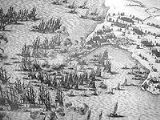
Siege of La Rochelle
Encyclopedia
The Siege of La Rochelle (French: Le Siège de La Rochelle, or sometimes Le Grand Siège de La Rochelle) was a result of a war between the French royal forces of Louis XIII of France
and the Huguenots of La Rochelle
in 1627-1628. The siege marked the apex of the tensions between the Catholics and the Protestants
in France, and ended with a complete victory for King Louis XIII and the Catholics.
 In the Edict of Nantes
In the Edict of Nantes
, Henry IV of France
had given the Huguenots extensive rights. La Rochelle had become the stronghold of the French Huguenots, under its own governance. It was the centre of Huguenot seapower, and the strongest centre of resistance against the central government.
La Rochelle
was, at this time, the second or third largest city in France with over 30,000 inhabitants.
The assassination of Henry IV in 1610, and the advent of Louis XIII under the regency of Marie de' Medici
, marked a return to pro-Catholic politics and a weakening of the position of the Protestants. The Duke Henri de Rohan and his brother Soubise
started to organize Protestant resistance from that time, ultimately exploding into a Huguenot rebellion. In 1621, Louis XIII besieged and captured Saint-Jean d'Angély, and a Blockade of La Rochelle
was attempted in 1621-1622, ending with a stalemate and the Treaty of Montpellier
.
Again, Rohan and Soubise would take arms in 1625, ending with the
capture of the Île de Ré in 1625 by Louis XIII. After these events, Louis XIII wished to subdue the Huguenots, and Louis' Chief Minister Cardinal Richelieu declared the suppression of the Huguenot revolt the first priority of the kingdom.
 The Anglo-French conflict followed the failure of the Anglo-French alliance of 1624, in which England had tried to find an ally in France against the power of the Habsburg
The Anglo-French conflict followed the failure of the Anglo-French alliance of 1624, in which England had tried to find an ally in France against the power of the Habsburg
. In 1626, France under Richelieu actually concluded a secret peace with Spain, and disputes arose around Henrietta Maria's household. Furthermore, France was building the power of its Navy, leading the English to be convinced that France must be opposed "for reasons of state".
In June 1626, Walter Montagu
was sent to France to contact dissident noblemen, and from March 1627 attempted to organize a French rebellion. The plan was to send an English fleet to encourage rebellion, triggering a new Huguenot revolt by Duke Henri de Rohan and his brother Soubise
.
sent a fleet of 80 ships, under his favourite George Villiers, 1st Duke of Buckingham
, to encourage a major rebellion in La Rochelle. In June 1627 Buckingham organised a landing on the nearby island of Île de Ré
with 6,000 men in order to help the Huguenots, thus starting an Anglo-French War (1627-1629)
, with the objective of controlling the approaches to La Rochelle, and of encouraging the rebellion in the city.
The city of La Rochelle initially refused to declare itself an ally of Buckingham, in a state of war against the crown of France, and effectively denied access to its harbour to Buckingham's fleet. An open alliance would only be declared in September at the time of the first fights between La Rochelle and Royal troops.
Although a Protestant stronghold, Île de Ré had not directly joined the rebellion against the king. On Ile de Ré
, the English under Buckingham tried to take the fortified city of Saint-Martin
in the Siege of Saint-Martin-de-Ré (1627)
, but were repulsed after three months. Small French Royal boats managed to supply St Martin in spite of the English blockade. Buckingham ultimately ran out of money and support, and his army was weakened by diseases. After a last attack on Saint-Martin they were repulsed with heavy casualties, and left with their ships.



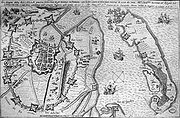
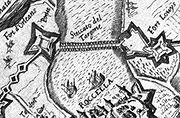
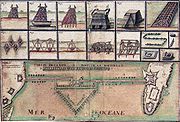
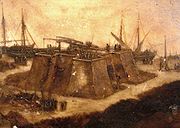 Meanwhile, in August 1627 Royal forces started to surround La Rochelle, with an army of 7,000 soldiers, 600 horses and 24 cannons, led by Charles of Angoulême
Meanwhile, in August 1627 Royal forces started to surround La Rochelle, with an army of 7,000 soldiers, 600 horses and 24 cannons, led by Charles of Angoulême
. They started to reinforce fortifications at Bongraine (modern Les Minimes
), and at the Fort Louis
.
On September 10, the first cannons shots were fired by La Rochelle against Royal troops at Fort Louis, starting the third Huguenot rebellion. La Rochelle was the greatest stronghold among the Huguenot cities of France, and the centre of Huguenot resistance. Cardinal Richelieu acted as the commander of the besieging troops (during those times when the King was absent).
Once hostilities started, French engineers isolated the city with entrenchments 12 kilometres long, fortified by 11 forts and 18 redoubts. The surrounding fortifications were totally completed in April 1628, manned with an army of 30,000.
They also built with 4,000 workmen a 1,400 metres long seawall
, to block the seaward access to the city. The initial idea for blocking the channel leading to the harbour of La Rochelle
in order to stop all supplies to the city came from the Italian engineer Pompeo Targone
, but his structure was broken by the winter weather, before the idea was taken up by the Royal architect Clément Metézeau
(also Metzeau), in November 1627. The wall was built on top of a foundation made of sunken hulks, filled with rubble. French artillery was used against English ships that tried to supply the city.
Meanwhile, in southern France, Henri de Rohan attempted to raise a rebellion in order to relieve La Rochelle, but in vain. Until February, some ships were able to go through the seawall under construction, but after March this became impossible. The city was completely blocked, with the only hope coming from a possible intervention of an English fleet.

s.
to the Gulf of Morbihan
as an affirmation of strategic support., arriving three weeks after the departure of Buckingham from Ile de Ré
. At one point, the Spanish fleet anchored in front of La Rochelle, but did not engage in actual operations against the city.
, Earl of Denbigh, left on April 1628, but returned without a fight to Portsmouth
, as Denbigh "said that he had no commission to hazard the king's ships in a fight and returned shamefully to Portsmouth".
in August 1628, consisting in 29 warships and 31 merchantmen.
In September 1628, the English fleet tried to relieve the city. After bombarding French positions and trying to force the sea wall in vain, the English fleet had to withdraw. Following this last disappointment, the city surrendered on October 28, 1628.

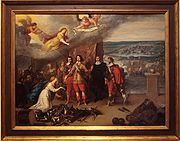
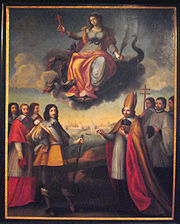 Residents of La Rochelle had resisted for 14 months, under the leadership of the mayor Jean Guitton and with the gradually diminishing help from England. During the siege, the population of La Rochelle decreased from 27,000 to 5,000 due to casualties, famine and disease.
Residents of La Rochelle had resisted for 14 months, under the leadership of the mayor Jean Guitton and with the gradually diminishing help from England. During the siege, the population of La Rochelle decreased from 27,000 to 5,000 due to casualties, famine and disease.
Surrender was unconditional. By the terms of the Peace of Alais
, the Huguenots lost their territorial, political and military rights, but retained the religious freedom granted by the Edict of Nantes
. However, they were left at the mercy of the monarchy, unable to resist later when Louis XIV abolished the Edict of Nantes altogether and embarked on active persecution.
Aside from its religious aspect, the result of Siege of La Rochelle marks an important stage in the creation of a strong central government in France, in actual control of its entire territory and intolerant of any regional defiance of its rule. In the immediate aftermath this was manifested in growth of absolute monarchy
, but had long-term effects upon all later French regimes up to the present.
The French philosopher Descartes is known to have visited the scene of the siege in 1627.
The siege was depicted in detail by numerous artists, such as Jacques Callot
.
coins were cast to describe the stakes of the siege, and then commemorate the Royal victory. These coins depict the siege in symbolic ways, showing the city and the English effort in a poor light, while putting an advantageous light on Royal might.
by Alexandre Dumas, père
and the book's numerous adaptaions to stage, screen, comics and video game.
The 11th book of Robert Merle
's Fortune de France series, La Gloire et les Perils, deals entirely with the siege of La Rochelle.
In Lawrence Norfolk
's 1991 novel, Lemprière's Dictionary, the siege is the central cause of events — entirely fictional — 160 years later in London around the writing of John Lemprière
's Classical Dictionary containing a full Account of all the Proper Names mentioned in Ancient Authors.
Louis XIII of France
Louis XIII was a Bourbon monarch who ruled as King of France and of Navarre from 1610 to 1643.Louis was only eight years old when he succeeded his father. His mother, Marie de Medici, acted as regent during Louis' minority...
and the Huguenots of La Rochelle
La Rochelle
La Rochelle is a city in western France and a seaport on the Bay of Biscay, a part of the Atlantic Ocean. It is the capital of the Charente-Maritime department.The city is connected to the Île de Ré by a bridge completed on 19 May 1988...
in 1627-1628. The siege marked the apex of the tensions between the Catholics and the Protestants
Protestant Reformation
The Protestant Reformation was a 16th-century split within Western Christianity initiated by Martin Luther, John Calvin and other early Protestants. The efforts of the self-described "reformers", who objected to the doctrines, rituals and ecclesiastical structure of the Roman Catholic Church, led...
in France, and ended with a complete victory for King Louis XIII and the Catholics.
Background

Edict of Nantes
The Edict of Nantes, issued on 13 April 1598, by Henry IV of France, granted the Calvinist Protestants of France substantial rights in a nation still considered essentially Catholic. In the Edict, Henry aimed primarily to promote civil unity...
, Henry IV of France
Henry IV of France
Henry IV , Henri-Quatre, was King of France from 1589 to 1610 and King of Navarre from 1572 to 1610. He was the first monarch of the Bourbon branch of the Capetian dynasty in France....
had given the Huguenots extensive rights. La Rochelle had become the stronghold of the French Huguenots, under its own governance. It was the centre of Huguenot seapower, and the strongest centre of resistance against the central government.
La Rochelle
La Rochelle
La Rochelle is a city in western France and a seaport on the Bay of Biscay, a part of the Atlantic Ocean. It is the capital of the Charente-Maritime department.The city is connected to the Île de Ré by a bridge completed on 19 May 1988...
was, at this time, the second or third largest city in France with over 30,000 inhabitants.
The assassination of Henry IV in 1610, and the advent of Louis XIII under the regency of Marie de' Medici
Marie de' Medici
Marie de Médicis , Italian Maria de' Medici, was queen consort of France, as the second wife of King Henry IV of France, of the House of Bourbon. She herself was a member of the wealthy and powerful House of Medici...
, marked a return to pro-Catholic politics and a weakening of the position of the Protestants. The Duke Henri de Rohan and his brother Soubise
Benjamin de Rohan, duc de Soubise
Benjamin de Rohan, duc de Soubise , was a French Huguenot leader.The younger brother of Henri de Rohan, he inherited his title through his mother Catherine of Parthenay. He served his apprenticeship as a soldier under Maurice of Nassau in the Low Countries...
started to organize Protestant resistance from that time, ultimately exploding into a Huguenot rebellion. In 1621, Louis XIII besieged and captured Saint-Jean d'Angély, and a Blockade of La Rochelle
Blockade of La Rochelle
The Blockade of La Rochelle took place in 1621-1622 during the repression of the Huguenot rebellion by the French king Louis XIII....
was attempted in 1621-1622, ending with a stalemate and the Treaty of Montpellier
Treaty of Montpellier
The Treaty of Montpellier was signed in Montpellier on October 18, 1622 between King Louis XIII of France and Duke Henry II of Rohan. The treaty followed the Siege of Montpellier and ended hostilities between French royalists and the Huguenots...
.
Again, Rohan and Soubise would take arms in 1625, ending with the
capture of the Île de Ré in 1625 by Louis XIII. After these events, Louis XIII wished to subdue the Huguenots, and Louis' Chief Minister Cardinal Richelieu declared the suppression of the Huguenot revolt the first priority of the kingdom.
English intervention

Habsburg
The House of Habsburg , also found as Hapsburg, and also known as House of Austria is one of the most important royal houses of Europe and is best known for being an origin of all of the formally elected Holy Roman Emperors between 1438 and 1740, as well as rulers of the Austrian Empire and...
. In 1626, France under Richelieu actually concluded a secret peace with Spain, and disputes arose around Henrietta Maria's household. Furthermore, France was building the power of its Navy, leading the English to be convinced that France must be opposed "for reasons of state".
In June 1626, Walter Montagu
Walter Montagu
Walter Montagu was an English courtier, secret agent and Benedictine abbot.-Life:He was the second son of Henry Montagu, 1st Earl of Manchester, by his first wife Catherine Spencer. He was born in the parish of St. Botolph Without, Aldersgate, London, and educated at Sidney Sussex College,...
was sent to France to contact dissident noblemen, and from March 1627 attempted to organize a French rebellion. The plan was to send an English fleet to encourage rebellion, triggering a new Huguenot revolt by Duke Henri de Rohan and his brother Soubise
Benjamin de Rohan, duc de Soubise
Benjamin de Rohan, duc de Soubise , was a French Huguenot leader.The younger brother of Henri de Rohan, he inherited his title through his mother Catherine of Parthenay. He served his apprenticeship as a soldier under Maurice of Nassau in the Low Countries...
.
First La Rochelle expedition
The English king Charles ICharles I of England
Charles I was King of England, King of Scotland, and King of Ireland from 27 March 1625 until his execution in 1649. Charles engaged in a struggle for power with the Parliament of England, attempting to obtain royal revenue whilst Parliament sought to curb his Royal prerogative which Charles...
sent a fleet of 80 ships, under his favourite George Villiers, 1st Duke of Buckingham
George Villiers, 1st Duke of Buckingham
George Villiers, 1st Duke of Buckingham KG was the favourite, claimed by some to be the lover, of King James I of England. Despite a very patchy political and military record, he remained at the height of royal favour for the first two years of the reign of Charles I, until he was assassinated...
, to encourage a major rebellion in La Rochelle. In June 1627 Buckingham organised a landing on the nearby island of Île de Ré
Île de Ré
Île de Ré is an island off the west coast of France near La Rochelle, on the northern side of the Pertuis d'Antioche strait....
with 6,000 men in order to help the Huguenots, thus starting an Anglo-French War (1627-1629)
Anglo-French War (1627-1629)
The Anglo-French war of 1627-1629 was part of the Thirty Years' War. It mainly involved actions at sea. The centre of the conflict surrounded the Siege of La Rochelle, in which the English crown supported the French Huguenots in their fight against the French royal forces of Louis XIII of France in...
, with the objective of controlling the approaches to La Rochelle, and of encouraging the rebellion in the city.
The city of La Rochelle initially refused to declare itself an ally of Buckingham, in a state of war against the crown of France, and effectively denied access to its harbour to Buckingham's fleet. An open alliance would only be declared in September at the time of the first fights between La Rochelle and Royal troops.
Although a Protestant stronghold, Île de Ré had not directly joined the rebellion against the king. On Ile de Ré
Île de Ré
Île de Ré is an island off the west coast of France near La Rochelle, on the northern side of the Pertuis d'Antioche strait....
, the English under Buckingham tried to take the fortified city of Saint-Martin
Saint-Martin-de-Ré
Saint-Martin-de-Ré is a commune in the Charente-Maritime department in southwestern France.It is one of the 10 communes located on the Île de Ré.-History:Saint-Martin-de-Ré has extensive fortifications, reflecting the strategic importance of the Île de Ré...
in the Siege of Saint-Martin-de-Ré (1627)
Siege of Saint-Martin-de-Ré (1627)
The Siege of Saint-Martin-de-Ré, also Siege of St. Martin's , occurred in the French isle of Ile de Ré around the fortress of the city of Saint-Martin-de-Ré, when Duke of Buckingham tried to occupy the island in 1627...
, but were repulsed after three months. Small French Royal boats managed to supply St Martin in spite of the English blockade. Buckingham ultimately ran out of money and support, and his army was weakened by diseases. After a last attack on Saint-Martin they were repulsed with heavy casualties, and left with their ships.
Siege







Charles de Valois, Duke of Angoulême
Charles de Valois was the Duke of Angoulême and the illegitimate son of Charles IX of France and Marie Touchet; born at the Château de Fayet in Dauphiné. His father, dying in the following year, commended him to the care and favour of his younger brother and successor, Henry III, who faithfully...
. They started to reinforce fortifications at Bongraine (modern Les Minimes
Les Minimes
Les Minimes, Port de plaisance des Minimes, is the largest marina in France for pleasure boats. It is located in the city of La Rochelle....
), and at the Fort Louis
Fort Louis (La Rochelle)
Fort Louis was a Royal fort built just outside the walls of the Huguenot city in La Rochelle.The fort was a source of great tension between the Huguenots of La Rochelle and Louis XIII, and was perceived as a real threat to their survival...
.
On September 10, the first cannons shots were fired by La Rochelle against Royal troops at Fort Louis, starting the third Huguenot rebellion. La Rochelle was the greatest stronghold among the Huguenot cities of France, and the centre of Huguenot resistance. Cardinal Richelieu acted as the commander of the besieging troops (during those times when the King was absent).
Once hostilities started, French engineers isolated the city with entrenchments 12 kilometres long, fortified by 11 forts and 18 redoubts. The surrounding fortifications were totally completed in April 1628, manned with an army of 30,000.
They also built with 4,000 workmen a 1,400 metres long seawall
Seawall
A seawall is a form of coastal defence constructed where the sea, and associated coastal processes, impact directly upon the landforms of the coast. The purpose of a seawall is to protect areas of human habitation, conservation and leisure activities from the action of tides and waves...
, to block the seaward access to the city. The initial idea for blocking the channel leading to the harbour of La Rochelle
La Rochelle
La Rochelle is a city in western France and a seaport on the Bay of Biscay, a part of the Atlantic Ocean. It is the capital of the Charente-Maritime department.The city is connected to the Île de Ré by a bridge completed on 19 May 1988...
in order to stop all supplies to the city came from the Italian engineer Pompeo Targone
Pompeo Targone
Pompeo Targone was an Italian military engineer in the service of Ambrose Spinola. He was famous for his role in the Siege of Ostend , the Siege of La Rochelle and the Huguenot wars...
, but his structure was broken by the winter weather, before the idea was taken up by the Royal architect Clément Metézeau
Clément Metézeau
Clément Métezeau , also Clément II Métezeau, was Royal architect of Louis XIII, and French engineer who completed the seawall blocking the city of La Rochelle in the Siege of La Rochelle in 1627–1628....
(also Metzeau), in November 1627. The wall was built on top of a foundation made of sunken hulks, filled with rubble. French artillery was used against English ships that tried to supply the city.
Meanwhile, in southern France, Henri de Rohan attempted to raise a rebellion in order to relieve La Rochelle, but in vain. Until February, some ships were able to go through the seawall under construction, but after March this became impossible. The city was completely blocked, with the only hope coming from a possible intervention of an English fleet.
Foreign support for the French Crown

Dutch support
Altogether, the Roman Catholic government of France rented ships from the Protestant city of Amsterdam to conquer the Protestant city of La Rochelle. This resulted in a debate in the city council of Amsterdam as to whether the French soldiers should be allowed to have a Roman Catholic sermon on board of the Protestant Dutch ships. The result of the debate was that it was not allowed. The Dutch ships transported the French soldiers to La Rochelle. France was a Dutch ally in the war against the HabsburgHabsburg
The House of Habsburg , also found as Hapsburg, and also known as House of Austria is one of the most important royal houses of Europe and is best known for being an origin of all of the formally elected Holy Roman Emperors between 1438 and 1740, as well as rulers of the Austrian Empire and...
s.
Spanish alliance
In the occasion of the Siege of La Rochelle, Spain manoeuvered towards the formation of a Franco-Spanish alliance against the common enemies that were the English, the Huguenots and the Dutch. Richelieu accepted Spanish help, and a Spanish fleet of 30 to 40 warships was sent from CadizCádiz
Cadiz is a city and port in southwestern Spain. It is the capital of the homonymous province, one of eight which make up the autonomous community of Andalusia....
to the Gulf of Morbihan
Gulf of Morbihan
The Gulf of Morbihan is a natural harbour on the coast of the Département of Morbihan in the south of Brittany, France. This English name is taken from the French version: le golfe du Morbihan...
as an affirmation of strategic support., arriving three weeks after the departure of Buckingham from Ile de Ré
Île de Ré
Île de Ré is an island off the west coast of France near La Rochelle, on the northern side of the Pertuis d'Antioche strait....
. At one point, the Spanish fleet anchored in front of La Rochelle, but did not engage in actual operations against the city.
Second La Rochelle expedition
The first one, led by William FeildingWilliam Feilding, 1st Earl of Denbigh
William Feilding, 1st Earl of Denbigh was an English naval officer and courtier.William Feilding was the son of Basil Fielding of Newnham Paddox in Warwickshire, , and of Elizabeth, daughter of Sir Walter Aston and his wife, Elizabeth Leveson.The descent of the Feildings from the house of Habsburg,...
, Earl of Denbigh, left on April 1628, but returned without a fight to Portsmouth
Portsmouth
Portsmouth is the second largest city in the ceremonial county of Hampshire on the south coast of England. Portsmouth is notable for being the United Kingdom's only island city; it is located mainly on Portsea Island...
, as Denbigh "said that he had no commission to hazard the king's ships in a fight and returned shamefully to Portsmouth".
Third La Rochelle expedition
A second fleet was dispatched under the Admiral of the Fleet, the Earl of LindseyRobert Bertie, 1st Earl of Lindsey
Robert Bertie, 1st Earl of Lindsey was an English peer, soldier and courtier.-Early life:...
in August 1628, consisting in 29 warships and 31 merchantmen.
In September 1628, the English fleet tried to relieve the city. After bombarding French positions and trying to force the sea wall in vain, the English fleet had to withdraw. Following this last disappointment, the city surrendered on October 28, 1628.
Epilogue



Surrender was unconditional. By the terms of the Peace of Alais
Peace of Alais
The Peace of Alais, also known as the Edict of Alès or the Edict of Grace, was a treaty negotiated by Cardinal Richelieu with Huguenot leaders and signed by King Louis XIII of France on 27 September 1629...
, the Huguenots lost their territorial, political and military rights, but retained the religious freedom granted by the Edict of Nantes
Edict of Nantes
The Edict of Nantes, issued on 13 April 1598, by Henry IV of France, granted the Calvinist Protestants of France substantial rights in a nation still considered essentially Catholic. In the Edict, Henry aimed primarily to promote civil unity...
. However, they were left at the mercy of the monarchy, unable to resist later when Louis XIV abolished the Edict of Nantes altogether and embarked on active persecution.
Aside from its religious aspect, the result of Siege of La Rochelle marks an important stage in the creation of a strong central government in France, in actual control of its entire territory and intolerant of any regional defiance of its rule. In the immediate aftermath this was manifested in growth of absolute monarchy
Absolute monarchy
Absolute monarchy is a monarchical form of government in which the monarch exercises ultimate governing authority as head of state and head of government, his or her power not being limited by a constitution or by the law. An absolute monarch thus wields unrestricted political power over the...
, but had long-term effects upon all later French regimes up to the present.
The French philosopher Descartes is known to have visited the scene of the siege in 1627.
The siege was depicted in detail by numerous artists, such as Jacques Callot
Jacques Callot
Jacques Callot was a baroque printmaker and draftsman from the Duchy of Lorraine . He is an important figure in the development of the old master print...
.
Numismatics
Around the time of the siege, a series of propagandaPropaganda
Propaganda is a form of communication that is aimed at influencing the attitude of a community toward some cause or position so as to benefit oneself or one's group....
coins were cast to describe the stakes of the siege, and then commemorate the Royal victory. These coins depict the siege in symbolic ways, showing the city and the English effort in a poor light, while putting an advantageous light on Royal might.
Siege in fiction and film
The siege forms the historical background for the novel The Three MusketeersThe Three Musketeers
The Three Musketeers is a novel by Alexandre Dumas, first serialized in March–July 1844. Set in the 17th century, it recounts the adventures of a young man named d'Artagnan after he leaves home to travel to Paris, to join the Musketeers of the Guard...
by Alexandre Dumas, père
Alexandre Dumas, père
Alexandre Dumas, , born Dumas Davy de la Pailleterie was a French writer, best known for his historical novels of high adventure which have made him one of the most widely read French authors in the world...
and the book's numerous adaptaions to stage, screen, comics and video game.
The 11th book of Robert Merle
Robert Merle
Robert Merle was a French novelist.-Biography:Born in Tébessa in French Algeria, he moved to France in 1918. A professor of English Literature at several universities, during World War II Merle was conscripted in the French army and assigned as an interpreter to the British Expeditionary Force...
's Fortune de France series, La Gloire et les Perils, deals entirely with the siege of La Rochelle.
In Lawrence Norfolk
Lawrence Norfolk
Lawrence Norfolk is a British novelist known for historical works with complex plots and intricate detail. His novels also feature an unusually large vocabulary....
's 1991 novel, Lemprière's Dictionary, the siege is the central cause of events — entirely fictional — 160 years later in London around the writing of John Lemprière
John Lemprière
John Lemprière , English classical scholar, lexicographer, theologian, teacher and headmaster...
's Classical Dictionary containing a full Account of all the Proper Names mentioned in Ancient Authors.

